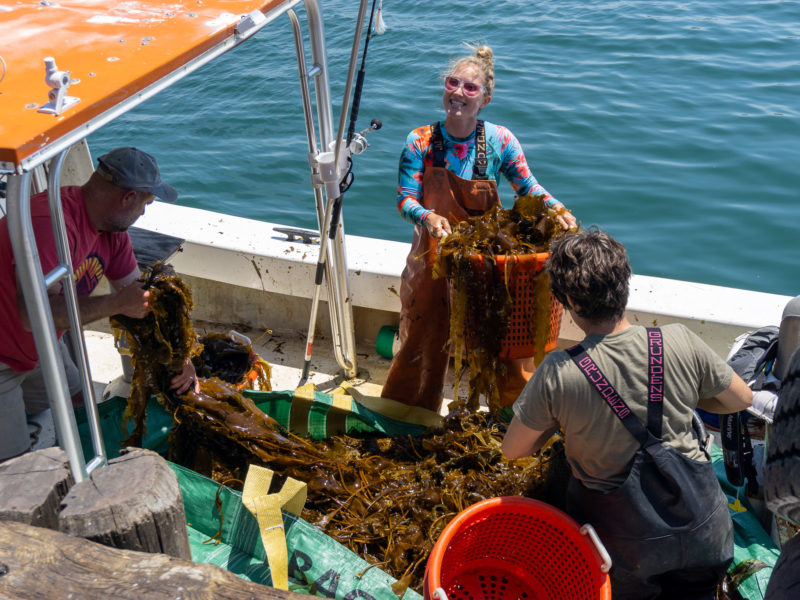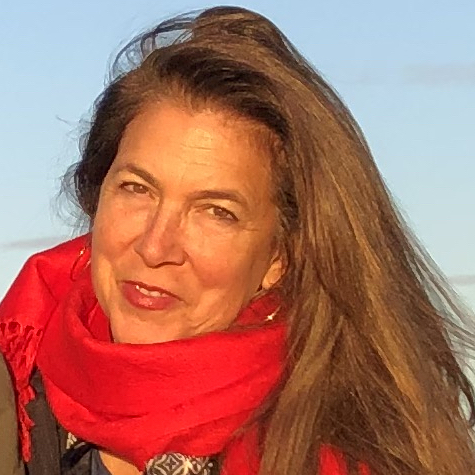

We’ve all been living in the Goldilocks period — what scientists have determined to be not too hot, not too cold, but just right for the birth of human civilization. I don’t know about you, but after 11,700 years, I’ve gotten quite used to it. Now we’re entering head-on into the Anthropocene era, a period defined by human domination and the catastrophic mess its created.
How has our misadventure in climate control affected the oceans? Over 90 percent of the heat produced from global warming is being absorbed into the oceans every year. As the water heats up, whole species of marine life are disappearing and much of the tropical oceans are becoming ocean deserts.
Right now would be the perfect time for seaweed to come to the rescue. It’s not a silver bullet, but the things these floppy little leaves can do for the planet are astonishing.
Growing seaweed, and more specifically kelp, is the most sustainable and prolific way to produce food on the planet. Seventy thousand square miles of seaweed farms (roughly the size of Washington state) would provide enough protein to feed the entire world population.
Considered the sequoia tree of coastal ecosystems, kelp forests sequester 20 times more CO2 than terrestrial forests. According to the World Bank, farming seaweed in less than 5 percent of U.S. waters could absorb 10 million tons of nitrogen and 135 million tons of carbon.
Ocean farming requires zero input from fertilizers, pesticides, herbicides, forest clearing, fuel burning machinery, or that most precious of diminishing resources — water.
Even if you don’t particularly like the taste of seaweed, this humble weed grows the big fish we love to eat. Wherever an anchor crop of seaweed has been planted, fish have come roaring back from near extinction. Think of these dense liquid forests as an enormous fish farm, but one where the fish would be diverse, free range and not wreaking havoc on the surrounding waters.
With a multitude of uses, seaweed is like the Swiss Army Knife of the sea. It can be turned into everything from biodegradable cups to bioplastic clothing. The most revolutionary use of seaweed is biofuel, which can be used to make biodiesel for cars, trucks, and airplanes.
When it comes to meeting the world’s energy needs, “It’s the equivalent of striking oil,” says U.C. Berkeley microbial biologist Anastasios Melis.
It’s one thing for kelp to reduce worldwide carbon emissions and feed the entire planet, but what about the Hamptons?
Here in the home of the eternal algae bloom, kelp could reduce the nitrogen that’s causing these toxic blooms. Cleaning up our bays would bring back marine life and the once robust commercial fishing industry that depends on it.
“Southampton has grown from 60,000 year-round residents to 240,000, so there’s a huge nitrogen pollution problem. We don’t have the infrastructure to handle it and it’s killing marine life,” says Tela Troge of Shinnecock Kelp Farmers.
With the third largest estuary in the U.S., Long Island is the ideal habitat for growing sugar kelp. When Stony Brook University conducted an experiment to see if they could grow sugar kelp in Long Island’s shallow South Shore estuaries, kelp blades grew to over 4 feet long in just three months, outpacing every known kelp farm project in New York and Connecticut, and defying the conventional wisdom that kelp needs deep water to grow.
Because kelp works in a symbiotic relationship with its fellow underwater climate warrior, the oyster, it would be an economic boon for local baymen. Kelp can be grown on the same lines that shellfish farmers are already using, and because it grows in the winter months, this shellfish-kelp duo could generate income in the off-season. It’s an industry that has the potential to produce annual sales of $47 million, according to Suffolk County statistics.
Kelp also protects our coastline. We got lucky with Henri, but hurricanes are in our future, and kelp beds would help buffer us against the worst effects of hurricanes by defusing wave energy.
While kelp farming is currently illegal in the state of New York, what’s known as “the kelp bill” has just passed in the Legislature and is waiting to be signed by Governor Kathy Hochul. State Assemblyman Fred W. Thiele Jr., who sponsored the bill, says that growing kelp reminds him of what farming was in the 1980s.
“It used to be all potatoes and cauliflower, then the farming industry was revitalized by grapes out here,” he says. “That’s how I look at kelp.”
I’ve always been a little bit afraid of seaweed. A California roll pretty much defined the edge of my comfort zone. But since I knew that I could help kelp help the planet by eating it, I pushed myself to experiment in the kitchen.
Here I found some ways for the culinarily challenged to cook with kelp:
Start slowly by sprinkling kelp flakes on grilled vegetables, salads, pizza and popcorn. Once you’ve branched out, you can find online recipes that use it in everything from coleslaw to chocolate chip cookies, guacamole to Bloody Mary mix. Some intrepid souls even substitute it for chewing tobacco. My favorite meal was a DLT using Dulce Kelp instead of bacon, because it had a surprisingly bacon-like flavor.
There are all kinds of underwater vegetables to play with. These are the big three:
Nori is a gateway seaweed, typically found in sushi rolls but it also makes a crunchy snack in its own right; Kelp (sometimes called Kombu) is great in soups and stir-fries; They say that Dulce kelp is the next kale. This seems unfair. Dulce has a smoky, savory crunch, while kale tastes like, well, kale.
Kelp is really good for you. This nutrient dense super food is packed with vitamins, minerals, antioxidants and proteins. It’s one of the only vegetables that contains vitamin B12 and is full of Omega-3 fatty acids.
Kelp is the only crop that makes fertilizer, rather than needing it. Where traditional fertilizer requires huge amounts of CO2 to produce and is a major contributor to the degradation of our estuaries, kelp fertilizer improves its environment. In a process called nutrient bio-extraction, harvested kelp removes nitrogen and carbon from coastal waters, and then turns around and converts it into healthy fertilizer.
If you really want to go big, consider planting your own kelp beds. Picture a farm with crops that you don’t have to drown in expensive product, or even water. With about $20,000, a boat, and a water lease, you could be putting seaweed lines in the water in four to eight months. Annually, a 20-acre regenerative ocean farm typically nets over $100,000.
According to Bren Smith, author of “Eat Like A Fish,” the logic in farming kelp is a no brainer.
“The ocean’s like, ‘Why don’t you grow things that don’t swim away and you don’t have to feed?’” he says. “When you look at the ocean that way, there are hundreds of kinds of shellfish, and thousands of plants we can grow. That opens up a whole frontier of agriculture.”
Kelp Resources:
Greenwave (greenwave.org): a nonprofit devoted to ocean farming — why it’s important, how it works, plus a great toolkit to help with farming methods, water leasing, budgeting, gear list etc.
“Eat Like A Fish” book by Bren Smith: Spot on account of the New England fishing industry, worldwide environmental issues, how to start a kelp farms, all peppered with a highly entertaining personal story (his teen years alone are a white-knuckle ride).
Montauk Seaweed Supply Company (montaukseaweed.com): Sea-to-soil pioneers who just launched the first locally made organic fertilizer. Where 95 percent of seaweed is transported from overseas, their team of Bonac Foragers and local regenerative kelp farmers means they have the lowest carbon footprint of any seaweed fertilizer available.
Eat More Kelp (eatmorekelp.com): First harvest won’t be until spring, but keep your eye out for some great climate cuisine coming from this Montauk CSKC (Community Supported Kelp Crop, kind of like a CSA)
Maine Coast Sea Vegetables (seaveg.com): huge variety of organic seaweeds. Available online in whole leaf, flakes, ground and powders. Check out their “cup of sea” tea.
Provisions: best local store to find a variety of seaweed, Dulce flakes and even seaweed shampoo.
 More Posts from Jenny Noble
More Posts from Jenny Noble